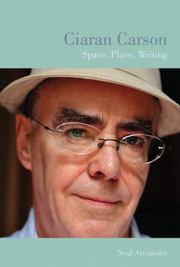Book contents
- Frontmatter
- Contents
- Acknowledgements
- Abbreviations
- Introduction
- Chapter 1 Imaginative Geographies: The Politics and Poetics of Space
- Chapter 2 Mapping Belfast: Urban Cartographies
- Chapter 3 Deviations from the Known Route: Reading, Writing, Walking
- Chapter 4 Revised Versions: Place and Memory
- Chapter 5 Spatial Stories: Narrative and Representation
- Chapter 6 Babel-babble: Language and Translation
- Bibliography
- General Index
- Index of Works
Chapter 3 - Deviations from the Known Route: Reading, Writing, Walking
- Frontmatter
- Contents
- Acknowledgements
- Abbreviations
- Introduction
- Chapter 1 Imaginative Geographies: The Politics and Poetics of Space
- Chapter 2 Mapping Belfast: Urban Cartographies
- Chapter 3 Deviations from the Known Route: Reading, Writing, Walking
- Chapter 4 Revised Versions: Place and Memory
- Chapter 5 Spatial Stories: Narrative and Representation
- Chapter 6 Babel-babble: Language and Translation
- Bibliography
- General Index
- Index of Works
Summary
Given his desire to know the street map with his feet, it is unsurprising that the act of walking should play such a prominent role in Carson's writing. Indeed, his is a distinctively peripatetic aesthetic. Time and again walking serves not only as a means of registering urban experience, the medium through which all manner of encounters, associations, and sidelong observations are made; it also functions as a figure for the meandering, digressive nature of Carson's narratives, in which ‘one thing leads to another’ (FFA, 152) much as the pedestrian wends her way through the divagating and interconnecting streets of the city. Form and content echo and reinforce each other in this respect, and in both his poetry and his prose Carson's wayward stories are very often told by narrators travelling on foot. This is true even of his translations, as the opening lines of The Inferno and The Midnight Court respectively show:
Halfway through the story of my life
I came to in a gloomy wood, because
I'd wandered off the path, away from the light.
(IDA, 1)'Twas my custom to stroll by a clear winding stream,
With my boots full of dew from the lush meadow green,
Near a neck of the woods where the mountain holds sway,
Without danger or fear at the dawn of the day.
(MC, 19)The implicit connection here between ‘strolling’, ‘wandering’, and ‘straying’ is important, for, as Rebecca Solnit observes, walking need not necessarily have a fixed destination but may serve as ‘a subversive detour, the scenic route through a half-abandoned landscape of ideas and experiences’.
- Type
- Chapter
- Information
- Ciaran CarsonSpace, Place, Writing, pp. 85 - 111Publisher: Liverpool University PressPrint publication year: 2010

